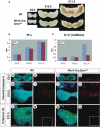Hedgehog signaling in the neural crest cells regulates the patterning and growth of facial primordia
- PMID: 15107405
- PMCID: PMC395852
- DOI: 10.1101/gad.1190304
Hedgehog signaling in the neural crest cells regulates the patterning and growth of facial primordia
Abstract
Facial abnormalities in human SHH mutants have implicated the Hedgehog (Hh) pathway in craniofacial development, but early defects in mouse Shh mutants have precluded the experimental analysis of this phenotype. Here, we removed Hh-responsiveness specifically in neural crest cells (NCCs), the multipotent cell type that gives rise to much of the skeleton and connective tissue of the head. In these mutants, many of the NCC-derived skeletal and nonskeletal components are missing, but the NCC-derived neuronal cell types are unaffected. Although the initial formation of branchial arches (BAs) is normal, expression of several Fox genes, specific targets of Hh signaling in cranial NCCs, is lost in the mutant. The spatially restricted expression of Fox genes suggests that they may play an important role in BA patterning. Removing Hh signaling in NCCs also leads to increased apoptosis and decreased cell proliferation in the BAs, which results in facial truncation that is evident by embryonic day 11.5 (E11.5). Together, our results demonstrate that Hh signaling in NCCs is essential for normal patterning and growth of the face. Further, our analysis of Shh-Fox gene regulatory interactions leads us to propose that Fox genes mediate the action of Shh in facial development.
Figures








References
-
- Ahlgren, S.C. and Bronner-Fraser, M. 1999. Inhibition of Sonic hedgehog signaling in vivo results in craniofacial neural crest cell death. Curr. Biol. 9: 1304–1314. - PubMed
-
- Barlow, A.J. and Francis-West, P.H. 1997. Ectopic application of recombinant BMP-2 and BMP-4 can change patterning of developing chick facial primordia. Development 124: 391–398. - PubMed
-
- Beverdam, A., Merlo, G.R., Paleari, L., Mantero, S., Genova, F., Barbieri, O., Janvier, P., and Levi, G. 2002. Jaw transformation with gain of symmetry after Dlx5/Dlx6 inactivation: Mirror of the past? Genesis 34: 221–227. - PubMed
-
- Carlsson, P. and Mahlapuu, M. 2002. Forkhead transcription factors: Key players in development and metabolism. Dev. Biol. 250: 1–23. - PubMed
-
- Chai, Y., Jiang, X., Ito, Y., Bringas, P., Han, J., Rowitch, D.H., Soriano, P., McMahon, A.P., and Sucov, H.M. 2000. Fate of the mammalian cranial neural crest during tooth and mandibular morphogenesis. Development 127: 1671–1679. - PubMed
Publication types
MeSH terms
Substances
Grants and funding
LinkOut - more resources
Full Text Sources
Other Literature Sources
Molecular Biology Databases
Research Materials
